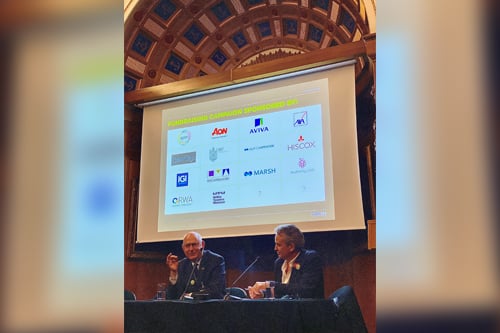

As part of his mentorship work with students in the East End of London, chairman of the Insurance Museum Initiative, Reg Brown would often take his students into the Bank of England Museum, and he would always leave asking himself the same question, “why haven’t we got a museum?”
Read more: CII’s big move – one year on
When researching the concept for an insurance museum, Brown examined Lloyd’s and noted that while they have a lot of interesting artefacts, many of these items are in its strong room and it was not open to the public. He then looked to the Aviva archive in Norwich and noted once more that the items were locked away.
Brown was subsequently asked by CII CEO, Sian Fisher, to head up a working group to decide what to do with these insurance artefacts and his suggestion was ready and waiting – “let’s set up an insurance museum.”
Director of OceanBarefoot, Jonathan Squirrell, described this museum as “the most exciting initiative in the insurance world today” and outlined how he became involved as project manager after he pitched the idea for a film about the heritage of the insurance sector.
“The public think of insurance as being boring,” Squirrell stated, and he outlined how “they need to get underneath the surface to really understand how big it is, how diverse a sector it is and how much depth there is to it.”
With Squirrell on board, the CII provided seed funding for a feasibility study for the Insurance Museum which was carried out from March through to August this year. He and Brown then went around the market consulting C-suite executives to recent graduates and everyone in between to build up a proposition around the Insurance Museum.
The result of this study found that it is feasible if the market wants it, and Squirrell detailed how the idea has been met with passion and enthusiasm from the vast majority of the insurance sector. Since then the project has been in fundraising mode, he said, and has amassed a broad variety of sponsors including Ageas, Aon, AXA, Hiscox, IGI, Guy Carpenter, Aviva Marsh, Willis Towers Watson, Beazley, Swiss Re, RWA, Mulberry Risk and with more coming on board.
Interesting content is essential to the development of the project, Squirrell outlined, and as well as the artefacts which have been collated over the years, there is also a focus on digital content. The experience must be engaging, he said, because the aim is to attract all audience groups from schoolchildren to academics to tourists.
“The beauty of insurance,” Squirrell said, “is you’ve got the freedom to talk about virtually anything.”
From climate change to cultural changes to world wars to historical events such as the Great Fire of London, you can build an exhibition around any topic, he stated. One of the early pitches for an exhibit that Squirrell outlined is the potential for a Virgin Galactic prototype in the visitor venue to promote discussion around the complexity of writing risk about subjects such as space travel.
The first phase of the Insurance Museum development involves the creation of a pop-up venue to last from three to five years, Squirrell outlined, and this venture is currently looking at potential venues that will meet its requirements in terms of space and location.
The venue required will be between 3,000 and 6,000 square feet, Squirrell stated, and will ideally be located in EC3. This location has been pinpointed as the insurance heartland, he said, but he specified that Insurance Museum is not a London-specific project, but is instead looking to tell the global story of insurance.
With the right location, conservative estimates have put the foot traffic of the Insurance Museum at about 200,000 visitors a year, Squirrell said, though he believes it will likely be significantly higher due to extensive advertising efforts and the high-profile nature of its sponsors.
There are some wonderful stories across the insurance sector, Squirrell said, and this project is a way of telling the story of insurance and what it enables – past, present and future to a new audience. This is a way to show how this profession has evolved throughout the ages, he said, and these stories are a valuable asset to the insurance sector which should be carefully preserved.
Insurance Museum is open for sponsorship and looking for everybody within and beyond the insurance sector to get involved. Many companies and individuals have already pledged their support to this project. They’re in, are you?
